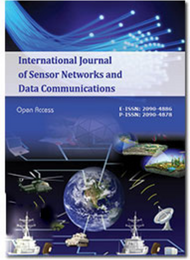Theme: Exploring The Innovations And Excellence In The Field Of Wireless, 5G And IOT
Wireless-2022
Conference Series LLC LTD organises 1000+ conferences every year across the USA, Europe, and Asia with support from 1000 more scientific societies and publishes 1000+ open access journals which have over 70000 followers. Conference Series Ltd invites all the participants across the globe to attend the international eminent personalities, reputed scientists as editorial board members, 1200 symposiums & workshops, and a 5 million summit on "Wireless, 5G & IoT".
We are glad to welcome you all to attend our "32nd World Summit on Wireless, 5G & IoT" scheduled for October 27-28, 2022 in Tokyo, Japan. WIRELESS-2022 provides an excellent global platform for professionals in the Wireless, 5G, and IoT fields by organising workshops, seminars, and B2B sessions in addition to the interactive gatherings from all over the world with a wide range of eminent speakers talking about their innovational discoveries to advance the aegis and medicaments of Wireless, 5G, and IoT.
A great opportunity to network with your peers from academia and industry:
- All the Stake Holders (both Academia & Industry) of the Sector
- Researchers & Innovators
- Experts Looking for Collaborative Work
- Product Developers
- Solution Providers
- Sales & Marketing Professionals
- Associations, Societies, & Professional Bodies
- Funding Agencies & Fund Raisers
- Management Bodies
- Decision Makers
Be the first to showcase your research, innovation and brand to gain competitive advantages. Meet your target audience and explore your product and services.
- To Meet Experts
- Learning In a New Space
- New Tips & Tactics
- Certification
- Global Networking
- Rebuild New Customer Base
- Brand Establishment
1. Wireless communication and networking
Wireless conversation is a vast term that includes all strategies and forms of connecting and speaking between two or more gadgets through the use of a wireless signal through wi-fi conversation technology and gadgets. Wireless networking is a way via which homes, telecommunications networks, and business installations avoid the pricey technique of introducing cables into a building, or as a connection among diverse system locations. Admin telecommunications networks are typically carried out and managed via radio communication. This implementation takes place on the physical stage (layer) of the OSI version network shape..
2. Radio Navigation
Radio navigation is the application of radio frequencies to determine the position of an object on earth. The basic principles are measurements from and to electric beacons. Combinations of these measurement principles are also important—e.g., many radars measure the range and azimuth of a target. Radio Navigation has huge applications in space organisations like ISRO (Indian Space Research Organisation) and NASA (The National Aeronautics and Space Administration).
3. IOT (Internet of Things)
The internet of things, or IoT, is a system of interrelated computing devices, mechanical and digital machines, objects, animals, or human beings that are furnished with precise identifiers (UIDs) and the capability to switch statistics over a community without requiring human-to-human or human-to-PC interplay. A person with a heart monitor implant, a farm animal with a biochip transponder, a car with integrated sensors to alert the driver when tyre pressure is low, or any other natural or man-made object that has been assigned an Internet Protocol (IP) deal with and is capable of exchanging data over a network can all be components of the internet of things.
4.Zigbee technology
Zigbee is nothing but a wireless technology, developed as an open global standard to address the unique needs of low-power wireless IOT networks. The Zigbee standard operates on the IEEE 802.15.4 physical radio specification. The main drawbacks of Zigbee technology are:Unlike Wi-Fi, if you have two devices with Zigbee chips, it's possible that they won't be able to operate with each other... Its maximum speed is just 250kbps, much lower than the lowest speed of Wi-Fi. The main advantage of Zigbee technology is that Zigbee's best quality is its lower power consumption rate and battery life.
5. 5G Terminology
5G (fifth generation remote systems) denotes a critical time of versatile media communications norms beyond the current 4G/IMT-Advanced standards.5G offers faster speeds than current 4G.The wireless and telecommunication conferences will include a thorough specialised technical programme offering various specialised sessions with papers exhibiting the most recent innovations, applications, and services. 5G ought to be taken off by 2020 to meet business and consumer demands. Notwithstanding giving just quicker speeds, they foresee that 5G networks also need to meet the needs of new use cases, for example, the Internet of Things, as well as broadcast-like services and lifeline communication in midst of natural disasters.
6. Optical Communication
Optical communication is any type of communication in which light is used to carry the signal to the remote end instead of electrical current. Optical communication relies on optical fibres to carry signals to their destinations. This communication was first developed in the 1970s. Fiber optics has revolutionised the telecommunication industry and played a major role in the advent of the information age. Because of its advantages over electrical transmission, optical fibres have largely replaced copper wire communications in core networks in the developed world.
7. Sensor Technology
A sensor is a device, module, machine, or subsystem whose purpose is to detect events or changes in its environment and send the information to other electronics, frequently a computer processor. All types of sensors can be basically classified into analogue and digital sensors.Nowadays, various sensor-based technologies have been adopted for construction safety management, including locating sensor-based technologies, vision-based sensing, and wireless sensor networks. Some advantages of sensors: It can detect through some containers, It can detect non-metallic targets. It senses all materials. Some of the drawbacks are: very sensitive to extreme environmental changes; sensitive to temperature changes as well.
8. Satellite Communication
A communication satellite is artificial satellite that transmits, receives, and amplifies radio transmission signals. This procedure is performed at different locations on earth. These communication satellites are utilised for TV, telephone, radio, internet, and military applications. A group of satellites working in concert is known as a satellite constellation.
Space exploration
Satellite Radiance
Earth Observation Satellites
Remote Sensing Satellites and GIS
9. Wireless models and simulation
Modeling and simulation (M&S) uses models (e.g., physical, mathematical, or logical illustrations of a gadget, entity, phenomenon, or procedure) as a foundation for simulations to broaden the statistics applied for managerial or technical decision making. In the laptop software of modelling and simulation, a PC is used to build a mathematical model which contains key parameters of the physical model. The mathematical model represents the physical model in virtual form, and situations are implemented that set up the test of the hobby. The simulation begins (i.e., the PC calculates the outcomes of those conditions on the mathematical model) and outputs results in a system- or human-readable format, depending on the implementation.
10. Intrusion detection techniques and approaches
Network and host-based intrusion detection systems are the most commonplace approaches to expressing this class, and you won't locate NNIDS noted very often in this space. Just think of it as a kind of NIDS. There are also two important tactics for detecting intrusion: signature-primarily based IDS and anomaly-based total IDS. Attackers can use several exclusive processes whilst trying to penetrate a machine. With network intruder detection software programmes, knowledge of what kinds of attacks may be used is seriously critical for putting in powerful prevention.
11. Mobile and Wireless Network
A wireless network is a computer network that uses wireless data connections for interfacing system hubs. LAN utilises radio waves to connect electronic gadgets to the Internet and to your business network and its applications. When you connect a workstation to a Wi-Fi hotspot in a public place, it connects to that business's wireless network. A wireless network empowers individuals to communicate and access applications and information in the absence of wires. This gives opportunity for development and the capacity to stretch out applications to various parts of a building, city, or about anyplace in the world. Wireless networks enable individuals to interact with e-mail or browse the Internet from their location.
12. Mobile networking and computing
Mobile Networking and Computing are concerned with designing green communications protocols and architectures for exchanging information amongst computers and cellular gadgets. The medical effects of the sphere enable a huge range of networked applications and beautify the real-global revel of network and cellular customers. Research areas investigated with the aid of our college include, but are not restrained to, aid management techniques in ad hoc, cell, and cognitive radio networks, difficult topics in sensor networks, which include intruder tracking, underwater sensors, and maximising fees of records,sensible sharing of wired and wireless bandwidth, and actual-time transmission of audio and video over wi-fi networks/Internet.
13. Orthogonal frequency division multiplexing (OFDM)
In telecommunications, orthogonal frequency-division multiplexing (OFDM) is a type of virtual transmission and a way of encoding virtual facts on more than one provider frequency. OFDM has evolved into a popular scheme for wideband digital communication, used in applications including virtual TV and audio broadcasting, DSL internet access, wireless networks, energy line networks, and 4G/5G cellular communications. OFDM is a frequency-division multiplexing (FDM) scheme that was introduced by Robert W. Chang of Bell Labs in 1966. In OFDM, a couple of intently spaced orthogonal subcarrier signals with overlapping spectra are transmitted to carry records in parallel.
14.Fair Power Utilization for Network Coverage Extension
This paper presents a relay choice algorithm based on truthful battery strength utilisation for extending mobile network insurance and capacity with the aid of a cooperative communication method where mobile gadgets can be used as relays. Cooperation improves the network performance for cell terminals, both with the aid of providing right of entry to out-of-variety devices or via facilitating multi-path network access to linked gadgets. In this paper, we expect that all mobile gadgets can benefit from using different cell devices as relays and check out the equity of relay choice algorithms. We point out that primarily electricity-based relay selection inevitably leads to unfair relay selection and devise a brand new algorithm based on fair usage of energy assets on mobile devices.
15. Mobile edge computing (MEC)
Technology resources are brought closer to the end user through multi-access edge computing (MEC). Due to the fact that data is processed and stored near the network's edge rather than a far-off data center, latency is drastically decreased. To support this real-time organization, MEC offers both a cloud computing environment and an IT service environment. Mobile edge computing exclusively refers to the edge of the mobile network, but multi-access edge computing relates to the edge of any network. A mobile edge computing platform called Verizon 5G Edge allows programmers to create apps for wireless edge devices with minimal latency.
The assessment report on the global wireless market for 2022 particularly identifies large business arrangements. The assessment considers the market's size, recent instances, motivators, dangers, and opportunities, as well as important market segments. It is based on historical data and current market demands. Incorporate certain commercial strategies that have been approved by the superiors. That promotes progress and serves as a fantastic replacement for the company. Between 2020 and 2028, the wireless market will generate a remarkable CAGR.
The report splits the entire market into focal members, geographic regions, and segments. Far-off communications assumes correspondence or transmission of information over a long distance without the use of wires, connections, or other electrical channels. Distant correspondence is one of the fastest growing business ventures as it is useful in sending and receiving messages via electronic devices and a distant medium.

The Global Wireless Technologies market 2019 assessment gives a principal blueprint of the business, including definitions, orders, applications, and industry chain structure. The Global Wireless Technologies market research examines the overall business areas, such as advancement designs, genuine scene assessment, and key locale progress status. Progression methodologies and plans are inspected similarly as gathering cycles and cost structures are researched. This report also states import/exchange usage, natural market figures, cost, worth, pay, and gross margins..
Conference Highlights
- Wireless communication and networking
- IOT (Internet of Things)
- Radio Navigation
- 5G Terminology
- Zigbee technology
- Sensor Technology
- Optical Communication
- Satellite Communication
- Wireless models and simulation
- Intrusion detection techniques and approaches
- Mobile and Wireless Network
- Mobile networking and computing
- Orthogonal frequency division multiplexing (OFDM)
- Intrusion detection techniques and approaches
- Mobile edge computing (MEC)
To share your views and research, please click here to register for the Conference.
To Collaborate Scientific Professionals around the World
| Conference Date | October 27-28, 2022 | ||
| Sponsors & Exhibitors |
|
||
| Speaker Opportunity Closed | |||
| Poster Opportunity Closed | Click Here to View | ||
Useful Links
Special Issues
All accepted abstracts will be published in respective Our International Journals.
Abstracts will be provided with Digital Object Identifier by













